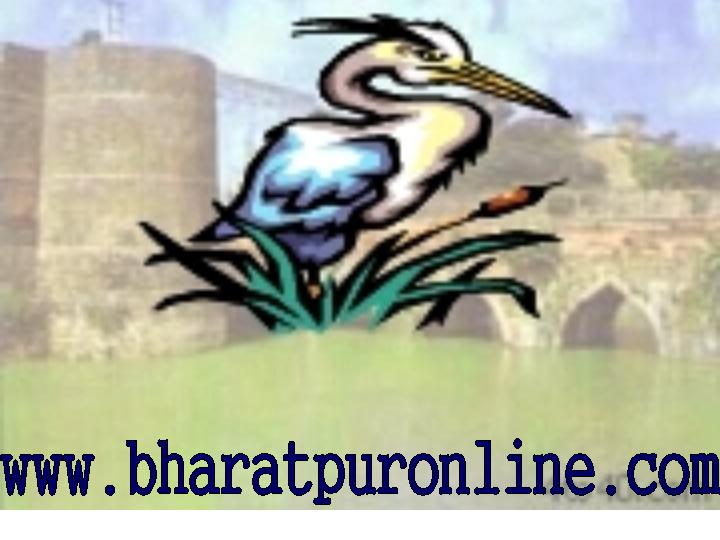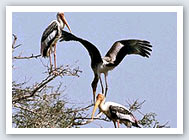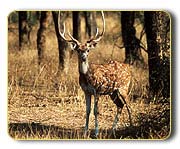 society N culture
society N culture
 city tour
city tour
 local
attractions
local
attractions |

Keoladeo National Park is the best place on Earth to watch Birds.
A paradise for the avian world, and the pilgrimage for the bird lovers, it was known as the best duck shooting resort in the British empire.
But was declared a reserve for birds in 1956 and later upgraded to National Park. UNESCO has listed it as a world heritage site.
The geographical location is ideal as it is on the main North - South avian route of India.
Once the royal hunting preserve of the princes of Bharatpur, it is one of the finest bird sanctuaries in the world
inundated with over 400 species of water birds. Kxoticmigratory birds from Afghanistan, Central Asia, Tibet as well as
Siberian cranes from the Arctic, graylag geese from Siberia and bar headed geese from China, come here in July/Aug to
spend the winters in the warmer climate and they breed till Oct/Nov. Colonies of cormorants, spoonbills. storks, egrets,
herons, pelicans, ebis and grey herons can be spotted all over the park. The raised paths camouflaged by babul trees make
their viewing easier.
Although small in size, 29 sq. km. only, it boasts to house more than 375 species of beautiful birds, and more than 132 of them breed inside the Keoladeo Ghana National Park and nearly every year new ones are added to the list. The sanctuary not only attracts birds from India but also from places like Europe, Siberia, China and Tibet.

Keoladeo National Park, situated just 5 km away from the city centre,has been India's former duck-hunting reserve of the
Maharajas. Hunting was prohibited by mid-60s. Formerly known as the Bharatpur Bird Sanctuary, the park was declared a national
park on 10 March 1982, and accepted as a World Heritage Site in December 1985.
Keoladeo is one of the major winter vacationing areas for large numbers of aquatic birds from Afghanistan, Turkmenistan,
China and Siberia. About 364 species of birds, including the rare Siberian crane, have been recorded in the park.
Origin of Keoladeo Park
The sanctuary was initially created by Maharaja Suraj Mal, because he had some great ideas – not of conservation, but of
the possibility of a constant supply of waterfowl for the royal dining table.

At that time, it used to be a scrubby depression
of land, seasonally enlivened by ephemeral ponds of water following the monsoons. These ponds attracted some unsuspecting
migratory ducks and geese in the winter months, and so Suraj Mal decided to turn it into a permanent reservoir, the Arjun
Bund. And soon, Bharatpur became one of India's most productive hunting reserves. So much so that the British officials used
to vie for invitations!
The 16 square miles of marsh known as the Ghana jheel (ghana means dense, and jheel lake) hosted such grand duck shoots that
no serious sportsman could afford to miss it. Colonel Sawai Brijendra Singh, a later maharaja of Bharatpur, explains: "The
jheel had islands to which I constructed little roads that were wide enough for cars to take VIPs out to their butts… Each
duck shoot took months to arrange and to see that VIPs were not given bad butts was like making the seating arrangement for
a dinner party. At the last moment someone would say, "Sorry, I can't come", and you then had to go through the list seeing
who should go into a VIP butt and who could have his place." Yet when it came to the largest bags, even Bharatpur had to give
way to the imperial sandgrouse shoots at Bikaner.
"Dusk in Bharatpur is owl time." The most spectacular of Bharatpur's eight species is the Indian eagle owl
 or great horned
owl, but dusky horned owls, mottled wood owls, spotted owlets and collared scope owls are found in the woodlands near water's
edge.
or great horned
owl, but dusky horned owls, mottled wood owls, spotted owlets and collared scope owls are found in the woodlands near water's
edge.
A Saga of Survival
The Siberian crane normally reaches Keoladeo before December and stays till March, a tradition which has been carried on
for thousands of years. This was rediscovered by German naturalist Peter S. Pallas in the 18th century. Traditionally, Fered
Unkenar in Iran and Keoladeo Ghana are the only two wintering places for the western race of the Siberian crane. It reaches
Bharatpur after a journey of 6,400 kilometres from the cold Siberian breeding grounds.
 Braving all the frost and blizzard of the Gobi desert and the Himalayas, the Sibes or Siberian cranes chose to come all the
way to bask in the warmth of Bharatpur during the winter months. Happily they flew in plenty before Ghana was formally created
by Bharatpur's maharaja. Then those terrible duck shoots began, and the poor creatures got frightened to their bones and
stopped their yearly visits. Much to the delight of ornithologists, these handsome birds appeared again in the 60s, long
after the killings had stopped. And by 1964-5 over 200 of them came to winter here. But happy times were short lived; their
numbers started dwindling again, and in 1990-1 only 10 cranes came. Then in 1994-5 none came at all. In 1996, however, four
Sibes were spotted in Keoladeo about two months after their usual time of arrival and ornithologists all over heaved a huge
sigh of relief.
Braving all the frost and blizzard of the Gobi desert and the Himalayas, the Sibes or Siberian cranes chose to come all the
way to bask in the warmth of Bharatpur during the winter months. Happily they flew in plenty before Ghana was formally created
by Bharatpur's maharaja. Then those terrible duck shoots began, and the poor creatures got frightened to their bones and
stopped their yearly visits. Much to the delight of ornithologists, these handsome birds appeared again in the 60s, long
after the killings had stopped. And by 1964-5 over 200 of them came to winter here. But happy times were short lived; their
numbers started dwindling again, and in 1990-1 only 10 cranes came. Then in 1994-5 none came at all. In 1996, however, four
Sibes were spotted in Keoladeo about two months after their usual time of arrival and ornithologists all over heaved a huge
sigh of relief.
All this definitely points to the gradual extinction of these wonderful birdes. The total population of the
Siberian crane now across the world is less than 2000.
There are many reasons to this lamentable depletion. A pair of breeding cranes raise only one chick a year, and though
the adult stands more than a mighty four feet tall, the tiny young ones often become the food for predatory shorebirds,
gulls and dogs. En route their migration to Bharatpur they have to face dangers that are even more dangerous than the
hostile terrain – guns. Every year many of these birds are shot down in Afghanistan and Pakistan, despite protective laws
in these countries. The remaining few alive reach Bharatpur exhausted, only to find that there's no food for them any more!
Courtesy, the Forest Department's brilliant policies.
In 1982 the Forest Department declared, in all sincerity, that villagers be moved out of the park with their bag and
baggage. They believed that the buffaloes owned by these villagers were readily depleting the park's resources. But what
the officials did not realize was that these buffaloes also ate up a lot of those weeds which were harmful for the growth of
the cranes' food plants. And the cranes being fussy about their food, ate only the rhizomes and tubers of some aquatic
plants, around which these weeds like the water hyacinth and certain sedges grew. Once the buffaloes were barred from the park
, these weeds grew rampant leading to the closure of the cranes' restaurant
The Avifauna
More than 375 species of birds are found in this small wildlife park of 29 sq-km out of which 11 sq-km are marshes and
the rest is scrubland and grassland. The beauty of this park is praiseworthy. When you are surrounded by the exhilarating
chirps of the beautiful birds, the entire ambience becomes heavenly, as you are amidst your favourites like Cranes, Pelicans,
Geese, Ducks, Eagles, Hawks, Shanks, Stints, Wagtails, Warblers, Wheatears, Flycatchers, Buntings, Larks and Pipits, etc.
Key Factors for a trip to this park
There are some attiquettes to be observed when visiting the parks as follows:
- Keep noise level down as noise may disturb the birds and animals of the park.
- Donot approach, treaten and feed the birds and animals.
- Donot smoke inside the park
- Donot hurt trees with graffite.
- Animals can look for their food themselves. Donot feed your own.
- Donot pluck flowers and shrubs.
- Donot try to go in the water
How to reach: Bharatpur in Rajasthan is south west of New Delhi on National Highway 11 and is connected by road to Agra (60km), Jaipur (180 km) and New Delhi (175 km via Fatehpur Sikri and Agra). Many trains from N Delhi (N Delhi - Mumbai and Agra - Jaipur route) stop at Bharatpur. Bharatpur is easily reached by train or bus, although private taxis from New Delhi or Agra are most often used. The Park gate is close to the bus stand and railway station.
Where to stay: Bharatpur has any number of hotel and private lodges. Santi Kutir and ITDC Forest Lodge are inside the park. Popular places include Wilderness Camp, Pelican and Sunbird ( all three close to the gate). I stayed at the new Kadam Kunj Hotel on the Jaipur - Agra road, 2 km from the park gate. I found it to be clean, well-appointed, reasonable and hospitable.
b>Park particulars: The Park is open all year from dawn to dusk. In winter the cycle-rickshaws get out of the Park by 6 pm. Entrance and camera fees (both nominal) are paid at the gate and checked inside at the barrier. Cycle-rickshaw guides charge INR 50/hour. Freelance naturalist guides are also available. Bicycles are available on hire at the gate or lodge where you stay and can be used to tour the Sanctuary.
Bharatpur has a network of tracks and many run along the water-bodies. They are best explored on foot or bicycles.
Strategy: 5 - 7 days is recommended if you are new to Keoladeo. Use a Cycle-rickshaw guide for the 1st day to get your bearings. Explore on bicycle/foot thereafter.
Best Time:
Best Time to Visit : Between the months of August-November for resident breeding birds and October- February for migrant birds.
Park Info.Ticket
The Park opens from sunrise to sunset around the year. The ticket is Rs 200 per foreign visitor and Rs 25 for Indian visitor. Vehicles are permitted upto Shanti Kutir about 1.7 kilometres inside at Rs 50 per vehicle. After this you can choose to walk, bicycle, or go by cycle rickshaw, Tonga or boat when the water level is high. The cycle rickshaw wallah’s displaying yellow plate meaning authorised double up as guides also carry binoculars. Hotels do supply packed lunches and you can get a bite at a canteen on the second gate and even at Forest Lodge
Location: 27*07'-27*12'N, 77*29'-77*33'E
Climate : Bharatpur is located on the fringes of the Thar desert. This marshy land has very warm climate. Summers are
invariably hot and winters are not very cold. Carry light cottons during summers and woolens during winters. Rainfall is
less but sufficient
Area : 29 sq-km.
You can reach the park by any means of transport - air, rail or road. But to venture into the park you need to hire a bicycle or cycle rickshaw. Or else you can also walk through the well defined paths of the park.
International Airport : At Delhi about 176 km from Bharatpur.
Nearest airport at Agra, (56 km) from Bharatpur.
Venture Into the park The Keoladeo
There are well defined forest paths in the Keoladeo. Get close to the bird life of Keoladeo by either walking or cycling
along the raised embankments. You can also hire a cycle rickshaw to explore the sanctuary. While you proceed through the dense forest cover, which shelters a diverse flora you will come across varied and colourful birds flying from one-side to the other side with high pitch melodious notes. The entire ambience seems to be heavenly, as you move further inside the park. The vast flora provides a natural habitat to these migratory birds. You must not have such number of birds at one place before.
Park Trips :
Covering about 29 sq km, the park has well-defined treks which can be easily covered on foot or on a cycle or you can also hire a rickshaw (the best way). They are available on hire. Rickshaw pullers have been trained by the park management in bird watching and are quite knowledgeable. Boats are also available on hire. A boat trip early in the morning or late evening is quite a rewarding experience. Do not forget to carry a binocular for watching the birds.
This is not all, the park also houses, some rare species of fauna like - Sambar, Chital, Nilgai and Boar.
Additional Punch
Bharatpur falls in the Golden Triangle route of India. So, you can extend your trip to the Golden Triangle Route which include - Delhi, Agra & Jaipur. The park is situated in the most enthralling state of India - Rajasthan. When you are so close to this royal land of India, how can you miss your trip to this place. But, the closest of the attractions are - Bharatpur Govenment Museum, Bharatpur Palace, Lohagarh Fort, Deeg Palace (32 km). The entire state will leave some mind-boggling experience in your life. But, if not possible, you can make you tour more flavoursome by visiting Jaipur (176 km), the capital city of Rajasthan.
Extend the Trip
Bhartapur is close to Agra (56 km). Agra - the home of the Taj Mahal is the place where everyone wants to be. And, when it is so close to your destination then how can you forget to include it in your tour itinerary. Delhi, the National City (India) is just 176 km from Bharatpur. If you keep keen interest in history of India, then this is the right place for you.
Few Difficulties
The summers are harsh here, so, it would be better if you can avoid Bharatpur during the summer months.
Few Suggestions
Contact a good travel agent, who has enough knowledge about the place and can understand the local culture and language. Try to visit the Park during the winters, as during this period you will be able to meet larger number of birds. Taste the unique Rajasthani cuisine, and know more about the Rajasthani culture.

Go to home Page
|
 education
system
education
system
 hospitals
hospitals
 industries
industries
|
 society N culture
society N culture
 city tour
city tour
 local
attractions
local
attractions 
 education
system
education
system  hospitals
hospitals industries
industries


 or great horned
owl, but dusky horned owls, mottled wood owls, spotted owlets and collared scope owls are found in the woodlands near water's
edge.
or great horned
owl, but dusky horned owls, mottled wood owls, spotted owlets and collared scope owls are found in the woodlands near water's
edge.
 Braving all the frost and blizzard of the Gobi desert and the Himalayas, the Sibes or Siberian cranes chose to come all the
way to bask in the warmth of Bharatpur during the winter months. Happily they flew in plenty before Ghana was formally created
by Bharatpur's maharaja. Then those terrible duck shoots began, and the poor creatures got frightened to their bones and
stopped their yearly visits. Much to the delight of ornithologists, these handsome birds appeared again in the 60s, long
after the killings had stopped. And by 1964-5 over 200 of them came to winter here. But happy times were short lived; their
numbers started dwindling again, and in 1990-1 only 10 cranes came. Then in 1994-5 none came at all. In 1996, however, four
Sibes were spotted in Keoladeo about two months after their usual time of arrival and ornithologists all over heaved a huge
sigh of relief.
Braving all the frost and blizzard of the Gobi desert and the Himalayas, the Sibes or Siberian cranes chose to come all the
way to bask in the warmth of Bharatpur during the winter months. Happily they flew in plenty before Ghana was formally created
by Bharatpur's maharaja. Then those terrible duck shoots began, and the poor creatures got frightened to their bones and
stopped their yearly visits. Much to the delight of ornithologists, these handsome birds appeared again in the 60s, long
after the killings had stopped. And by 1964-5 over 200 of them came to winter here. But happy times were short lived; their
numbers started dwindling again, and in 1990-1 only 10 cranes came. Then in 1994-5 none came at all. In 1996, however, four
Sibes were spotted in Keoladeo about two months after their usual time of arrival and ornithologists all over heaved a huge
sigh of relief.